 The guys at the gym laughed when I told them we don’t do footy tipping in my workplace: we do competitive reading. The competition involves my colleagues at Writers Victoria, together with the staff and volunteers of all the co-resident organisations in The Wheeler Centre where we are located. I read 45 books this year (that I can remember), a couple more than last year, but nowhere near as many as the front runners. And once again, I’m choosing ‘Reading Bingo’ as a framework for reflecting on my year of reading.
The guys at the gym laughed when I told them we don’t do footy tipping in my workplace: we do competitive reading. The competition involves my colleagues at Writers Victoria, together with the staff and volunteers of all the co-resident organisations in The Wheeler Centre where we are located. I read 45 books this year (that I can remember), a couple more than last year, but nowhere near as many as the front runners. And once again, I’m choosing ‘Reading Bingo’ as a framework for reflecting on my year of reading.
A book with more than 500 pages
 Clare Wright’s You Daughters of Freedom clocks in at 560 pages but reads with the pace of a thriller. The book captures a time when a newly Federated Australia took pride in championing progressive politics, not only leading the way on delivering political rights to (white) women, but taking the success of our suffrage campaign overseas. The story is told through through the eyes of five movers and shakers — Vida Goldstein, Nellie Martel, Dora Montefiore, Muriel Matters, and Dora Meeson Coates — whom I hope will become household names, thanks to Wright’s outstanding research and story telling. I had the great pleasure of being in conversation with Clare about You Daughters of Freedom at the Word for Word Festival in Geelong in November and could’ve talked with her all day about this book.
Clare Wright’s You Daughters of Freedom clocks in at 560 pages but reads with the pace of a thriller. The book captures a time when a newly Federated Australia took pride in championing progressive politics, not only leading the way on delivering political rights to (white) women, but taking the success of our suffrage campaign overseas. The story is told through through the eyes of five movers and shakers — Vida Goldstein, Nellie Martel, Dora Montefiore, Muriel Matters, and Dora Meeson Coates — whom I hope will become household names, thanks to Wright’s outstanding research and story telling. I had the great pleasure of being in conversation with Clare about You Daughters of Freedom at the Word for Word Festival in Geelong in November and could’ve talked with her all day about this book.
A forgotten classic
 Elizabeth Harrower’s novel The Watch Tower was first published the year I was born, and re-released in 2012 as part of the Text Classics series — which I believe qualifies it as both forgotten (albeit temporarily) and a classic. Set in Sydney in the 1940s, The Watch Tower is a terrifying study of power and control, rendered in exquisite prose. The Watch Tower was Michelle de Kretser’s choice for a book club session at this year’s Melbourne Writers Festival, which I was fortunate enough to host. Elizabeth Harrower’s own advice to anyone who’s even thinking of being a writer is to ‘read endlessly and read great books forever’. I’m grateful to Michelle, herself a writer of great books, for drawing my attention to this great book.
Elizabeth Harrower’s novel The Watch Tower was first published the year I was born, and re-released in 2012 as part of the Text Classics series — which I believe qualifies it as both forgotten (albeit temporarily) and a classic. Set in Sydney in the 1940s, The Watch Tower is a terrifying study of power and control, rendered in exquisite prose. The Watch Tower was Michelle de Kretser’s choice for a book club session at this year’s Melbourne Writers Festival, which I was fortunate enough to host. Elizabeth Harrower’s own advice to anyone who’s even thinking of being a writer is to ‘read endlessly and read great books forever’. I’m grateful to Michelle, herself a writer of great books, for drawing my attention to this great book.
A book that became a movie
 I didn’t read any books that became movies as such in 2018, but if I was to wager on which of the books I read might become a movie, I reckon Irish-born, Western Australian author Dervla McTiernan’s gripping debut crime novel, The Rúin, would be a strong contender. In 1993, rookie cop Cormac Reilly is sent to a house in Galway, where he finds two neglected children, their mother dead in her bed from a drug overdose. Twenty years later, having forged a successful career in Dublin, Reilly returns to Galway, where another death forces him to revisit the case that still haunts him. I could see Colin Farrell or Cillian Murphy in the lead role, with maybe Saoirse Ronan as Aisling Conroy…
I didn’t read any books that became movies as such in 2018, but if I was to wager on which of the books I read might become a movie, I reckon Irish-born, Western Australian author Dervla McTiernan’s gripping debut crime novel, The Rúin, would be a strong contender. In 1993, rookie cop Cormac Reilly is sent to a house in Galway, where he finds two neglected children, their mother dead in her bed from a drug overdose. Twenty years later, having forged a successful career in Dublin, Reilly returns to Galway, where another death forces him to revisit the case that still haunts him. I could see Colin Farrell or Cillian Murphy in the lead role, with maybe Saoirse Ronan as Aisling Conroy…
A book published this year
 Just over half the books I read this year were published in 2018, or are slated for publication in 2019 — a perk of my job. The 2018 release I’m highlighting on this bingo square is The Fireflies of Autumn and Other Tales of San Ginese by Italian-born Australian writer Moreno Giovannoni. Giovannoni won the inaugural Deborah Cass Prize for Migrant Writing, and his winning entry forms part of this fresh, unsentimental though lyrical and often funny collection of stories. This was a book I savoured, reluctant to finish and thus be forced to wrest myself away from San Ginese and its beguiling, sometimes baffling occupants. The Fireflies of Autumn also has one of my favourite cover designs of 2018.
Just over half the books I read this year were published in 2018, or are slated for publication in 2019 — a perk of my job. The 2018 release I’m highlighting on this bingo square is The Fireflies of Autumn and Other Tales of San Ginese by Italian-born Australian writer Moreno Giovannoni. Giovannoni won the inaugural Deborah Cass Prize for Migrant Writing, and his winning entry forms part of this fresh, unsentimental though lyrical and often funny collection of stories. This was a book I savoured, reluctant to finish and thus be forced to wrest myself away from San Ginese and its beguiling, sometimes baffling occupants. The Fireflies of Autumn also has one of my favourite cover designs of 2018.
A book with a number in the title
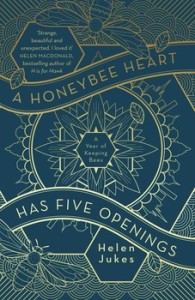 After leaving this square blank in 2017, I’m able to complete it this year with A Honeybee Heart Has Five Openings by UK writer Helen Jukes. Honeybee Heart is a memoir focusing on a year in which Jukes, an overworked staffer at a UK charity organisation, decides to keep bees in her Oxford garden. The book draws on ancient history, natural history and linguistics in its study of the relationship between humans and bees and what it means to ‘keep’ wild creatures, though much of Jukes’s story is about finding connection—the ‘unpredictable, knotty business of attachment’. I had the pleasure of interviewing Jukes at a Melbourne Writers Festival (MWF) session called ‘Birds & Bees’, at which she made a compelling case for ensuring the survival of her beloved species.
After leaving this square blank in 2017, I’m able to complete it this year with A Honeybee Heart Has Five Openings by UK writer Helen Jukes. Honeybee Heart is a memoir focusing on a year in which Jukes, an overworked staffer at a UK charity organisation, decides to keep bees in her Oxford garden. The book draws on ancient history, natural history and linguistics in its study of the relationship between humans and bees and what it means to ‘keep’ wild creatures, though much of Jukes’s story is about finding connection—the ‘unpredictable, knotty business of attachment’. I had the pleasure of interviewing Jukes at a Melbourne Writers Festival (MWF) session called ‘Birds & Bees’, at which she made a compelling case for ensuring the survival of her beloved species.
A book written by an author under thirty
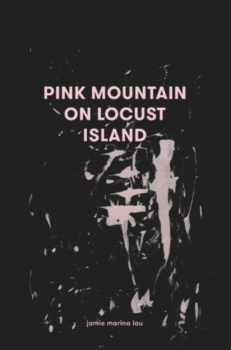 Jamie Marina Lau was 21 when her novel Pink Mountain on Locust Island, was published this year — not that it shows in her prose. The story centres on Monk, a teen living in Chinatown with her washed-up painter father, and their uneasy relationship with an interloper called Santa Coy. I felt the same way about the book as reviewer Ellen Cregan: ‘Where this book shines most clearly is on a line level. I read the whole thing very quickly … and occasionally I had to consciously slow myself down in order to enjoy the wonderfully abject prose. Lau’s writing is something else. She doesn’t sound like anyone I’ve read before … Anyone interested in writing that is formally experimental should put this book at the top of their reading pile.’
Jamie Marina Lau was 21 when her novel Pink Mountain on Locust Island, was published this year — not that it shows in her prose. The story centres on Monk, a teen living in Chinatown with her washed-up painter father, and their uneasy relationship with an interloper called Santa Coy. I felt the same way about the book as reviewer Ellen Cregan: ‘Where this book shines most clearly is on a line level. I read the whole thing very quickly … and occasionally I had to consciously slow myself down in order to enjoy the wonderfully abject prose. Lau’s writing is something else. She doesn’t sound like anyone I’ve read before … Anyone interested in writing that is formally experimental should put this book at the top of their reading pile.’
A book with non-human characters
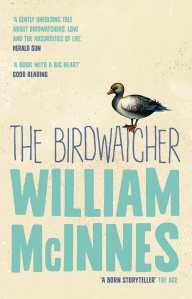 Another square I left blank last year is this year claimed by The Birdwatcher by William McInnes, which features a curlew called Picnic, who likes being read to, especially from Ian Fleming’s novel Goldfinger. One of the main human characters, Clare, notes that, ‘As an audience, Picnic has been pretty good, tilting her head this way and that, only occasionally needing a bit of biscuit.’ I came across this absolutely charming novel in the course of preparing to interview Will for the MWF session, ‘Birds & Bees’ alongside Helen Jukes. I subsequently sent The Birdwatcher to my mum, who was going through a rough health patch, and she confirmed my instinct that this is a great read for hard times.
Another square I left blank last year is this year claimed by The Birdwatcher by William McInnes, which features a curlew called Picnic, who likes being read to, especially from Ian Fleming’s novel Goldfinger. One of the main human characters, Clare, notes that, ‘As an audience, Picnic has been pretty good, tilting her head this way and that, only occasionally needing a bit of biscuit.’ I came across this absolutely charming novel in the course of preparing to interview Will for the MWF session, ‘Birds & Bees’ alongside Helen Jukes. I subsequently sent The Birdwatcher to my mum, who was going through a rough health patch, and she confirmed my instinct that this is a great read for hard times.
A funny book
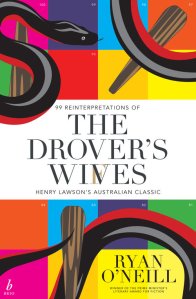 For the second consecutive year, I’m allocating this square to a work by Ryan O’Neill: this time to The Drover’s Wives, O’Neill’s 2018 release, which features 99 riffs on the Henry Lawson classic Australian short story, ‘The Drover’s Wife’. Before I’d even read this book, I gave it to a friend for his birthday, and we laughed till we cried just skimming through the table of contents. Reading the stories, I laughed even more. Among my personal favourites: ‘The Drover’s Wife’ as ‘A Year 8 English Essay’ (No. 4), as ‘Editorial Comments’ (No. 17), and as ‘An Amazon Book Review’ (No. 42), the latter written in all caps and opening with the line ‘DON’T READ THIS BOOK. NO, REALLY. DON’T!’ By contrast, my advice is READ THIS BOOK. NO, REALLY. DO!
For the second consecutive year, I’m allocating this square to a work by Ryan O’Neill: this time to The Drover’s Wives, O’Neill’s 2018 release, which features 99 riffs on the Henry Lawson classic Australian short story, ‘The Drover’s Wife’. Before I’d even read this book, I gave it to a friend for his birthday, and we laughed till we cried just skimming through the table of contents. Reading the stories, I laughed even more. Among my personal favourites: ‘The Drover’s Wife’ as ‘A Year 8 English Essay’ (No. 4), as ‘Editorial Comments’ (No. 17), and as ‘An Amazon Book Review’ (No. 42), the latter written in all caps and opening with the line ‘DON’T READ THIS BOOK. NO, REALLY. DON’T!’ By contrast, my advice is READ THIS BOOK. NO, REALLY. DO!
A book by a female author
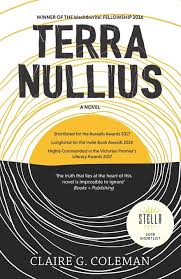 Yet again, I wonder how ‘a book by a female author’ can even be a bingo reading category, given 35 out of the 45 books I read this year were written by women. I’m allocating this square to a work by Noongar author Claire G Coleman, Terra Nullius. I met Claire at the start of the year at the Victorian Premier’s Literary Awards, where Terra Nullius was highly commended. In the novel, Claire uses speculative fiction to devastating effect to illustrate that what settler Australians think of as dystopian, Indigenous Australians experience as reality. A timely and powerful book.
Yet again, I wonder how ‘a book by a female author’ can even be a bingo reading category, given 35 out of the 45 books I read this year were written by women. I’m allocating this square to a work by Noongar author Claire G Coleman, Terra Nullius. I met Claire at the start of the year at the Victorian Premier’s Literary Awards, where Terra Nullius was highly commended. In the novel, Claire uses speculative fiction to devastating effect to illustrate that what settler Australians think of as dystopian, Indigenous Australians experience as reality. A timely and powerful book.
A book with a mystery
 Toni Jordan’s new novel, The Fragments, is a literary thriller — one of my favourite sub-genres — set between Brisbane in 1986 and New York in 1938-39. In Brisbane, Caddie Walker is obsessed with author Inga Karlson who, after publishing a sensational debut novel, perished in a warehouse fire in New York in 1939 in mysterious circumstances, together with all known copies of her second novel. In New York, we follow Inga through the eyes of Rachel, whose relationship with Inga transforms her life. The story is an exquisite evocation of time and place, and a reflection on the power of books and stories. ‘Books are time travel and space travel and mood-altering drugs,’ writes Jordan. ‘They are mind-melds and telepathy and past-life regression.’ A truly gorgeous read.
Toni Jordan’s new novel, The Fragments, is a literary thriller — one of my favourite sub-genres — set between Brisbane in 1986 and New York in 1938-39. In Brisbane, Caddie Walker is obsessed with author Inga Karlson who, after publishing a sensational debut novel, perished in a warehouse fire in New York in 1939 in mysterious circumstances, together with all known copies of her second novel. In New York, we follow Inga through the eyes of Rachel, whose relationship with Inga transforms her life. The story is an exquisite evocation of time and place, and a reflection on the power of books and stories. ‘Books are time travel and space travel and mood-altering drugs,’ writes Jordan. ‘They are mind-melds and telepathy and past-life regression.’ A truly gorgeous read.
A book with a one word title
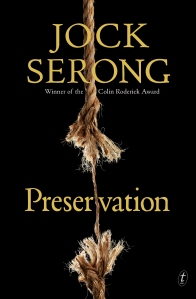 Anyone who knows me well knows that I’m a huge fan of Jock Serong’s writing. His latest novel, released in September, is Preservation is a historical thriller based on a real-life shipwreck in 1797 off what was then Van Dieman’s Land. Seventeen men — British merchant seamen and Bengali lascars — set out from the wreck to travel to Sydney. Months later, three survivors are picked up just south of the colonial town. Serong fills the gaps in the historical account with a tense, sometimes menacing narrative, told from the point of view of different characters, including one of the lascars and the wife of a lieutenant in Sydney assigned to investigate. Particularly powerful is his imaginative evocation of south coast Aboriginal nations prior to settlement. Highly recommended.
Anyone who knows me well knows that I’m a huge fan of Jock Serong’s writing. His latest novel, released in September, is Preservation is a historical thriller based on a real-life shipwreck in 1797 off what was then Van Dieman’s Land. Seventeen men — British merchant seamen and Bengali lascars — set out from the wreck to travel to Sydney. Months later, three survivors are picked up just south of the colonial town. Serong fills the gaps in the historical account with a tense, sometimes menacing narrative, told from the point of view of different characters, including one of the lascars and the wife of a lieutenant in Sydney assigned to investigate. Particularly powerful is his imaginative evocation of south coast Aboriginal nations prior to settlement. Highly recommended.
A book of short stories
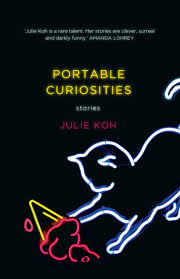 Of the four short story collections I read this year, I’m highlighting Julie Koh’s stunning collection, Portable Curiosities. Koh’s creative choices are mind-bending — if you’ve ever wondered how the narrative voice of a pair of perfect breasts might sound, look no further — her prose lyrical, often breathtaking. I had the pleasure of meeting Julie briefly at the Newcastle Writers Festival in April, where she spoke on a panel, together with Ryan O’Neill and Jane Rawson, called ‘Outside the Square: Is experimentation in Australian literature dead?’ Judging by both the size of the audience in Newcastle and the strength of Koh’s collection, the answer to that question is a resounding ‘no’.
Of the four short story collections I read this year, I’m highlighting Julie Koh’s stunning collection, Portable Curiosities. Koh’s creative choices are mind-bending — if you’ve ever wondered how the narrative voice of a pair of perfect breasts might sound, look no further — her prose lyrical, often breathtaking. I had the pleasure of meeting Julie briefly at the Newcastle Writers Festival in April, where she spoke on a panel, together with Ryan O’Neill and Jane Rawson, called ‘Outside the Square: Is experimentation in Australian literature dead?’ Judging by both the size of the audience in Newcastle and the strength of Koh’s collection, the answer to that question is a resounding ‘no’.
A free square
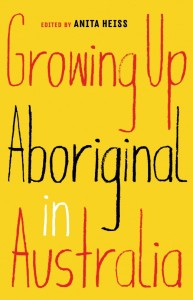 I’m allocating my free square this year to the anthology, Growing Up Aboriginal in Australia, edited by the luminous Anita Heiss, with whom I had the great pleasure of sharing a panel at the Word for Word Festival in Geelong. Growing Up Aboriginal is, to borrow a current affairs cliché, a book no Australian can afford to miss. The collection of personal essays shines a light on the breadth and depth of the Aboriginal experience in Australia, not to mention the significant talents of our First Nations people. Not all contributors are writers, but all are storytellers, and their stories are enlightening, often moving and sometimes enraging.
I’m allocating my free square this year to the anthology, Growing Up Aboriginal in Australia, edited by the luminous Anita Heiss, with whom I had the great pleasure of sharing a panel at the Word for Word Festival in Geelong. Growing Up Aboriginal is, to borrow a current affairs cliché, a book no Australian can afford to miss. The collection of personal essays shines a light on the breadth and depth of the Aboriginal experience in Australia, not to mention the significant talents of our First Nations people. Not all contributors are writers, but all are storytellers, and their stories are enlightening, often moving and sometimes enraging.
A book set on a different continent
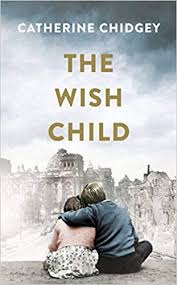 Fourteen of the 36 works of fiction I read in 2019 were set outside Australia, including The Wish Child by New Zealand author Catherine Chidgey. The Wish Child tells the story of two children: Sieglinde, who comes from a middle-class family in Berlin, her father working as a censor for the Third Reich, and Erich, who lives in rural Germany with his mother, whose stories collide as Germany comes apart. Part of the novel’s power comes from recounting the Nazi propaganda through the children’s eyes. But the real suckerpunch is the revelation of the narrator at the end of the story. When I interviewed Catherine Chidgey at Adelaide Writers Week in March, she mentioned that The Wish Child had not been reviewed in Australia, a shame as it deserves way more attention than it has received here.
Fourteen of the 36 works of fiction I read in 2019 were set outside Australia, including The Wish Child by New Zealand author Catherine Chidgey. The Wish Child tells the story of two children: Sieglinde, who comes from a middle-class family in Berlin, her father working as a censor for the Third Reich, and Erich, who lives in rural Germany with his mother, whose stories collide as Germany comes apart. Part of the novel’s power comes from recounting the Nazi propaganda through the children’s eyes. But the real suckerpunch is the revelation of the narrator at the end of the story. When I interviewed Catherine Chidgey at Adelaide Writers Week in March, she mentioned that The Wish Child had not been reviewed in Australia, a shame as it deserves way more attention than it has received here.
A book of non-fiction
 I read nine works of non-fiction this year, most in preparation for writers’ festivals, including Skin in the Game: The Pleasure and Pain of Telling True Stories by Sonya Voumard, whom I interviewed on a panel at the Word for Word Festival. Voumard’s collection melds personal essays with political commentary to great effect, documenting both her life as a journalist and demise of print journalism. Particularly intriguing are Voumard’s encounters with Helen Garner, whom she interviewed for a university essay in 1980, incurring Garner’s wrath in the process — an experience she revisited with Garner 31 years later. This process renewed Voumard’s appreciation of her interview subjects, aware that interviewing is ‘often intimate, provocative and invasive’.
I read nine works of non-fiction this year, most in preparation for writers’ festivals, including Skin in the Game: The Pleasure and Pain of Telling True Stories by Sonya Voumard, whom I interviewed on a panel at the Word for Word Festival. Voumard’s collection melds personal essays with political commentary to great effect, documenting both her life as a journalist and demise of print journalism. Particularly intriguing are Voumard’s encounters with Helen Garner, whom she interviewed for a university essay in 1980, incurring Garner’s wrath in the process — an experience she revisited with Garner 31 years later. This process renewed Voumard’s appreciation of her interview subjects, aware that interviewing is ‘often intimate, provocative and invasive’.
The first book by a favourite author
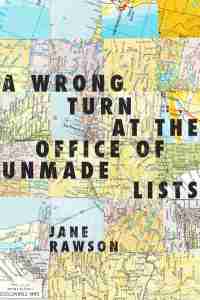 I’m not sure if this category refers to a debut novel by an author whose work you already admire, or the first book you’ve read by an author who is destined become a ‘favourite’. I’m taking it as a combination of both. Jane Rawson is a person I’ve admired for some time, having seen her interviewed at festivals, listened to her on radio, followed on Twitter, but never got around to reading. This year, I finally got to her debut novel, the wonderfully titled A Wrong Turn at the Office of Unmade Lists, winner of the SPN award for the Most Underrated Book of 2014. On the strength of this darkly humorous, deeply unsettling story, I feel Jane is destined to become a favourite author.
I’m not sure if this category refers to a debut novel by an author whose work you already admire, or the first book you’ve read by an author who is destined become a ‘favourite’. I’m taking it as a combination of both. Jane Rawson is a person I’ve admired for some time, having seen her interviewed at festivals, listened to her on radio, followed on Twitter, but never got around to reading. This year, I finally got to her debut novel, the wonderfully titled A Wrong Turn at the Office of Unmade Lists, winner of the SPN award for the Most Underrated Book of 2014. On the strength of this darkly humorous, deeply unsettling story, I feel Jane is destined to become a favourite author.
A book you heard about online
 I’ve mostly ceased reviewing on this blog, due to time constraints, combined with the sensitivities of trying to reflect critically on works when you also head up the peak body for writers in the state. However, I’m still on the mailing list for a number of publishing houses, giving me access to information on books I might not otherwise hear about. One example that came through from the publicists at Hachette is Robert Mackin’s Dragon & Kangaroo: Australia and China’s shared history from the goldfields to the present day. This important study does not make for easy reading, dealing as it does with historical atrocities and successive waves of racism directed at the Chinese in Australia. But like all good histories, it is both engaging and enlightening.
I’ve mostly ceased reviewing on this blog, due to time constraints, combined with the sensitivities of trying to reflect critically on works when you also head up the peak body for writers in the state. However, I’m still on the mailing list for a number of publishing houses, giving me access to information on books I might not otherwise hear about. One example that came through from the publicists at Hachette is Robert Mackin’s Dragon & Kangaroo: Australia and China’s shared history from the goldfields to the present day. This important study does not make for easy reading, dealing as it does with historical atrocities and successive waves of racism directed at the Chinese in Australia. But like all good histories, it is both engaging and enlightening.
A best selling book
 At the Small Press Network conference in November, Bianca Whiteley from Nielsen BookScan reported that Christian White’s debut, The Nowhere Child (Affirm Press), was not only the highest selling adult fiction title for a small Australian publisher in 2018, but the highest selling book by small publishers overall. So I bumped it up my TBR pile. Nearly 30 years after two-year-old Sammy Went disappears from her home in small town Kentucky, Sammy’s brother approaches Melbourne-based Kim Leamy, convinced she is his missing sister and giving her enough grounds to travel to the USA to investigate. Growing darker as it closes in on the serpent handling religious cult of which Sammy’s family was a part, the plot kept me guessing, while delivering a satisfying twist at the end. I can see what all the fuss is about.
At the Small Press Network conference in November, Bianca Whiteley from Nielsen BookScan reported that Christian White’s debut, The Nowhere Child (Affirm Press), was not only the highest selling adult fiction title for a small Australian publisher in 2018, but the highest selling book by small publishers overall. So I bumped it up my TBR pile. Nearly 30 years after two-year-old Sammy Went disappears from her home in small town Kentucky, Sammy’s brother approaches Melbourne-based Kim Leamy, convinced she is his missing sister and giving her enough grounds to travel to the USA to investigate. Growing darker as it closes in on the serpent handling religious cult of which Sammy’s family was a part, the plot kept me guessing, while delivering a satisfying twist at the end. I can see what all the fuss is about.
A book based on a true story
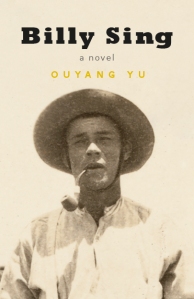 It was in Dragon & Kangaroo where I read about William Edward ‘Billy’ Sing, an Australian-born Eurasian of Chinese and British parentage who was the most celebrated ANZAC sniper of World War I. Chinese-Australian writer Ouyang Yu’s Billy Sing (Transit Lounge) consciously resists any notion of the ANZAC legend, however, in favour of what reviewer Terri Ann Quan Sing (quoting one of Yu’s poems) calls ‘a a sniper’s rifle that shoots a ‘fuck you’ into the heart of White Australia’. The power of this novella is in the narrative voice, described by Quan Sing as ‘poetically playful, painful, gruff, churlish, and sometimes obscene’. Based on a true story, but revealing deeper, more uncomfortable truths as a work of fiction.
It was in Dragon & Kangaroo where I read about William Edward ‘Billy’ Sing, an Australian-born Eurasian of Chinese and British parentage who was the most celebrated ANZAC sniper of World War I. Chinese-Australian writer Ouyang Yu’s Billy Sing (Transit Lounge) consciously resists any notion of the ANZAC legend, however, in favour of what reviewer Terri Ann Quan Sing (quoting one of Yu’s poems) calls ‘a a sniper’s rifle that shoots a ‘fuck you’ into the heart of White Australia’. The power of this novella is in the narrative voice, described by Quan Sing as ‘poetically playful, painful, gruff, churlish, and sometimes obscene’. Based on a true story, but revealing deeper, more uncomfortable truths as a work of fiction.
A book at the bottom of your to be read pile
 I’d been meaning to read Emily Bitto’s award-winning debut novel The Strays since it won the Stella Prize in 2015. I booked Emily to teach a workshop for Writers Victoria in 2018 on ‘Writing Exquisite Sentences’, which proved so popular, we ran it three times. Signing up to volunteer at the third workshop, prompted me to read The Strays at last. I’m so glad I did: I loved the story of Lily, an only child, whose life is transformed by her friendship with Eva, daughter of Bohemian artists in 1930s Melbourne. A meditation on art, class, childhood, friendship and legacy, the writing also demonstrates why Emily Bitto was the perfect tutor for writing exquisite sentences (and it was a fabulous workshop).
I’d been meaning to read Emily Bitto’s award-winning debut novel The Strays since it won the Stella Prize in 2015. I booked Emily to teach a workshop for Writers Victoria in 2018 on ‘Writing Exquisite Sentences’, which proved so popular, we ran it three times. Signing up to volunteer at the third workshop, prompted me to read The Strays at last. I’m so glad I did: I loved the story of Lily, an only child, whose life is transformed by her friendship with Eva, daughter of Bohemian artists in 1930s Melbourne. A meditation on art, class, childhood, friendship and legacy, the writing also demonstrates why Emily Bitto was the perfect tutor for writing exquisite sentences (and it was a fabulous workshop).
Honorable mentions, too, to Heather Rose’s Museum of Modern Love and Extinctions by Josephine Wilson, both wonderful book previously on, and now off, the TBR pile.
A book your friend loves
 Usually, I fill this square with a book recommended by my mother, but this year, it’s one recommended by my daughter. Both of us are long-standing fans of Gabrielle Wang’s books for young readers (Ghost in My Suitcase, In the Garden of Empress Cassia, and the Our Australian Girl: Meet Pearlie series being among our favourites), and though my daughter and I rarely read the same books now that I no longer read aloud to her, she urged me to read Little Paradise, too. Inspired by a true story (the front cover features a photograph of Wang’s mother), Little Paradise is set in Melbourne and Shanghai during the 1940s. Shedding light on the civil war in China, it is at its heart a beautiful love story. Highly recommended by me and Miss (Then) Twelve.
Usually, I fill this square with a book recommended by my mother, but this year, it’s one recommended by my daughter. Both of us are long-standing fans of Gabrielle Wang’s books for young readers (Ghost in My Suitcase, In the Garden of Empress Cassia, and the Our Australian Girl: Meet Pearlie series being among our favourites), and though my daughter and I rarely read the same books now that I no longer read aloud to her, she urged me to read Little Paradise, too. Inspired by a true story (the front cover features a photograph of Wang’s mother), Little Paradise is set in Melbourne and Shanghai during the 1940s. Shedding light on the civil war in China, it is at its heart a beautiful love story. Highly recommended by me and Miss (Then) Twelve.
A book that scares you
The books that scare me usually do so because of their political implications — Kamila Shamsie’s depiction of the radicalisation of young Muslim men in Home Fire being the perfect example. But this year, I’m giving this square to The Nowhere Child, as it contains what is for me one of the most horrifying scenes in literature since Winston Smith entered Room 101 in George Orwell’s 1984.
A book that is more than 10 years old
The Watch Tower was the only book I managed to read this year that was more than ten years old. I might have to aim for a ‘classic’ or two in 2019.
A book with a blue cover
 I feel like I already covered this with Little Paradise, so I’m going to mention a book with some blue on the cover. In addition to Michelle de Kretser’s book club at Melbourne Writers Festival, I also put up my hand to host a session with Sarah Krasnostein — mostly because it meant I would prioritise reading Kranostein’s multi-award-winning book The Trauma Cleaner about the life of Sandra Pankhurst. This was reward enough. But Sarah’s choice of book for discussion, Elizabeth Strout’s By Name is Lucy Barton, also blew me away. I read it from cover to cover in one sitting, then read it again a few weeks later. My Name is Lucy Barton is a poignant story that sheds light on how poverty shapes lives, while Strout’s prose demonstrate the power of simple language used to full effect.
I feel like I already covered this with Little Paradise, so I’m going to mention a book with some blue on the cover. In addition to Michelle de Kretser’s book club at Melbourne Writers Festival, I also put up my hand to host a session with Sarah Krasnostein — mostly because it meant I would prioritise reading Kranostein’s multi-award-winning book The Trauma Cleaner about the life of Sandra Pankhurst. This was reward enough. But Sarah’s choice of book for discussion, Elizabeth Strout’s By Name is Lucy Barton, also blew me away. I read it from cover to cover in one sitting, then read it again a few weeks later. My Name is Lucy Barton is a poignant story that sheds light on how poverty shapes lives, while Strout’s prose demonstrate the power of simple language used to full effect.
In terms of holiday reading, I’ve just finished Katherine Collette’s debut The Helpline, which was funny and heartening — the perfect leisure read. Next up is Warlight by Michael Ondaatje, my Christmas present from my mother.
What were some of your best reads of 2018?
Here’s wishing you a New Year filled with great reads.

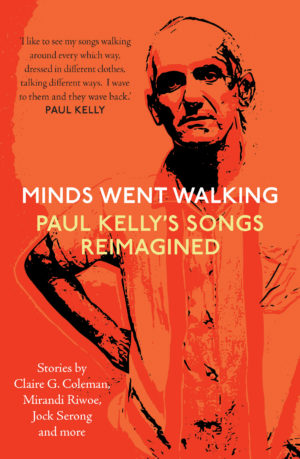
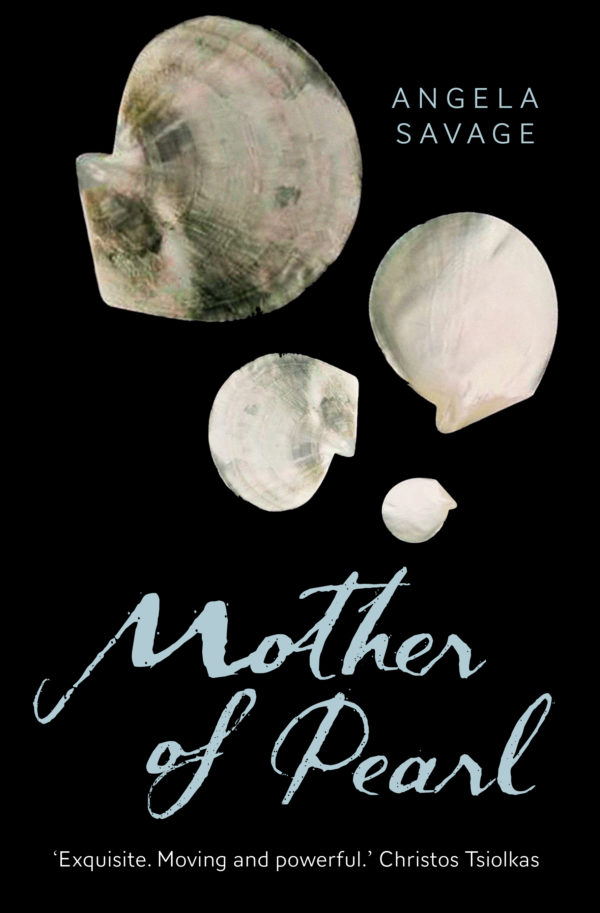
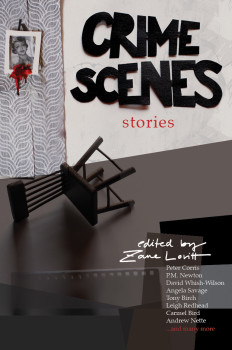



I’ve read nearly all your choices, Angela, and I especially like that you’ve included a Kiwi title. If you like experimental fiction, do take a look at The Beat of the Pendulum also by Chidgey, see https://anzlitlovers.com/2018/02/10/the-beat-of-the-pendulum-by-catherine-chidgey/ We should get her back to talk about this book at one of our forthcoming festivals because it’s exceptional.
Oh, and BTW, The Wish Child had indeed been reviewed in Australia, back in 2017, see https://anzlitlovers.com/2017/08/16/the-wish-child-by-catherine-chidgey
LikeLiked by 1 person
Hi Lisa, thanks for dropping by and for your comments. I actually did read The Beat of the Pendulum – that was the book I interviewed Catherine about alongside Rachel Khong (Goodbye, VItamin) at Adelaide Writers Week. TBH, I wasn’t as much of a fan of The Beat of the Pendulum as I was of The Wish Child – perhaps because I read the latter first and it was such a hard act to follow. Thanks for the link to the review. I think Catherine was particularly disappointed that ABR didn’t review it.
Happy reading to you in 2019 and I look forward as always to your reflections.
LikeLiked by 1 person
Ah well *wry smile* the ABR doesn’t have much room left for ‘local’ reviews, Between their copious reviews of US fiction and other aspects of the arts such as drama, they are a pale shadow of what they were, and I unsubscribed a couple of years ago. I think they are now irrelevant to most ordinary readers.
LikeLike
Happy New Year to you, too, Angela. You’ve had a good year of reading, and there are several here that have caught my eye. I agree with you about Serong, so I want to read that one. And there are about three or four others that I am going to try to wedge onto my TBR pile…
LikeLiked by 1 person
Thanks Margot. Serong has had a great year, with On The Java Ridge winning two major awards in the past few months, including the inaugural Staunch Prize. The new one is not a traditional crime novel, but the tension, violence and mystery that underpins the story will suit fans of the genre.
Happy reading and writing to you in 2019.
LikeLiked by 1 person
Always fun to see what’s being read “down under” – as usual I haven’t heard of most of them. Agree totally about the book by a woman category – I changed it a couple of years ago to science fiction book because it always annoys me so much…! Happy New Year when it comes. 😀
LikeLiked by 1 person
I like your sense of anarchy, FF! The book by a woman square stays for me as an annual tally of how many books by women that I’ve read; and as you can tell, I stretched the ‘book with a blue cover’ category so I could mention a book I loved. Thanks for all the wonderful blogging in 2018 & happy reading and writing in 2019.
LikeLiked by 1 person
I just love, love the idea of a book bingo and I am intrigued by what comes up in a reading year when you follow this. I read Watch Tower when I was reading for my PhD, and it made me so claustrophobic I had to sit near a window and read so I could look out at the garden, and breathe. Such a horrifying and excellent book. The Ruin and The Fragments is next on my list too. And I tend to read mostly Australian women so I have to actually wrench myself away to read ‘others.’ A good problem to have, I think.
LikeLiked by 1 person
Thanks Rashida. I like the bingo meme as an alternative to ‘best of’ lists and for the particular slant it puts on my year of reading. I agree with you about The Watch Tower. I was in awe of the way the aptly named Harrower could transform Sydney’s bright sunlight into something menacing. My reading is also heavily slanted towards Australian women – nothing we have to apologise for!
LikeLike
I did a bingo last year, but I may not make it this year. They’re fun though. There are a few books here that I’ve read, some I haven’t and some I really want to – like Portable curiosities and a book, any book, by Strout! Of the few I haven’t read, the one I’d most like to read is O’Neill’s Drovers wives. I bought Preservation for my Mum to give Mr Gums. I hope he enjoys it.
LikeLiked by 1 person
Oh, and I love The watchtower. It is such a powerful, unforgettable read – and I read it around the time of its re-release.
Forgot to say, that I also bought Serong’s On Java Ridge for my Mum to give my son! So he did well here too!
LikeLiked by 1 person
Jock Serong has done very well out of the Gums family Xmas!
Thanks for all the great blogging in 2018, Sue, and here’s to another great year of reading & reviewing in 2019.
LikeLiked by 1 person
He did, strangely, even though I haven’t read him yet. I hope he’s appreciated!
Thanks to you too Angela… I enjoy our little Aussie community of writers, readers and/or blogging.
LikeLiked by 1 person
Knowing Jock, he’ll very much appreciate this. And do read his work — I’m confident it will impress you.
LikeLiked by 1 person
I’ll try to read the one I gave Mr Gums
LikeLiked by 1 person
Well. That I bought someone else to give him.
LikeLiked by 1 person
Omigosh. I must bookmark this page. There are so many great titles here which I want to read. (give up everywhere else and read). I loved The Birdwatcher, the only book I read on this list. But there are so many I’ve never heard of before which are intriguing. Particularly, I like to read about life in Australia, especially for Indigenous people.
Have a good reading year.
LikeLike
I read several good books last year, mysteries and noncrime fiction. I recommend particularly Where the Drawdads Sing, by Delia Owen. A mystery with beautiful description writing about the marshes of North Carolina and a girl who must raise herself with whatever resources she can find. Owen is a science writer, and this is her first novel. It’s at the top of the best-seller lists at the NY Times now, but that is no reason to not read it. It’s good.
LikeLike
Pingback: Reading Bingo 2019 | Angela Savage